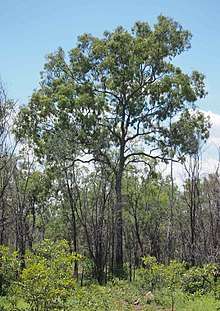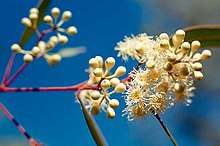Corymbia trachyphloia
Corymbia trachyphloia, commonly known as the brown bloodwood,[2] is a species of small to medium-sized tree that is endemic to eastern Australia. It has rough, tessellated bark on the trunk, often also on the larger branches, lance-shaped adult leaves, flower buds in groups of seven, white flowers and urn-shaped fruit.
| Brown bloodwood | |
|---|---|
 | |
| Corymbia trachyphloia near the Blackdown Tableland | |
| Scientific classification | |
| Kingdom: | Plantae |
| Clade: | Tracheophytes |
| Clade: | Angiosperms |
| Clade: | Eudicots |
| Clade: | Rosids |
| Order: | Myrtales |
| Family: | Myrtaceae |
| Genus: | Corymbia |
| Species: | C. trachyphloia |
| Binomial name | |
| Corymbia trachyphloia | |
| Synonyms[1] | |
|
synonyms
| |


Description
Corymbia trachyphloia is a tree that typically grows to a height of 15 m (49 ft) and forms a lignotuber. It has rough, brown and greyish bark on the trunk, often also on the larger branches. Young plants and coppice regrowth have lance-shaped, glossy green leaves that are paler on the lower surface, 50–120 mm (2.0–4.7 in) long, 10–35 mm (0.39–1.38 in) wide and petiolate, the petiole is attached to the underside of the leaf blade. Adult leaves are usually glossy dark green, paler on the lower surface, narrow lance-shaped to lance-shaped, 65–140 mm (2.6–5.5 in) long and 9–26 mm (0.35–1.02 in) wide, tapering to a petiole 8–20 mm (0.31–0.79 in) long, The flower buds are arranged on a branched peduncle 4–13 mm (0.16–0.51 in) long, each branch of the peduncle with seven buds on pedicels 2–7 mm (0.079–0.276 in) long. Mature buds are pear-shaped, 4–5 mm (0.16–0.20 in) long and 2–4 mm (0.079–0.157 in) wide with a rounded operculum. Flowering occurs from December to June and the flowers are white. The fruit is a thin-walled, urn-shaped capsule 6–10 mm (0.24–0.39 in) long and 5–8 mm (0.20–0.31 in) wide with the valves enclosed in the fruit.[2][3][4]
Taxonomy and naming
The brown bloodwood was first formally described in 1859 by Ferdinand von Mueller who gave it the name Eucalyptus trachyphloia and published the description in the Journal of the Proceedings of the Linnean Society, Botany from specimens collected near the Burnett River.[5][6] In 1995, Ken Hill and Lawrie Johnson changed the name to Corymbia trachyphloia, publishing the change in the journal Telopea.[4][7]
Distribution and habitat
Corymbia trachyphloia usually grows in sandy soils on plains and sandstone outcrops from the Goulburn River in New South Wales and north to the Blackdown Tableland, Carnarvon Range and Atherton Tableland in Queensland.[2][3]
See also
References
- "Corymbia trachyphloia". Australian Plant Census. Retrieved 29 February 2020.
- "Corymbia trachyphloia Brown bloodwood". Euclid: Centre for Australian National Biodiversity Research. Retrieved 29 February 2020.
- Chippendale, George M. "Eucalyptus trachyphloia". Australian Biological Resources Study, Department of Agriculture, Water and the Environment, Canberra. Retrieved 29 February 2020.
- Hill, Kenneth D.; Johnson, Lawrence A.S. (1995). "Systematic studies in the eucalypts. 7. A revision of the bloodwoods, genus Corymbia (Myrtaceae)". Telopea. 6 (2–3): 227–231.
- "Eucalyptus trachyphloia". APNI. Retrieved 29 February 2020.
- von Mueller, Ferdinand (1859). "Monograph of the Eucalypti of Tropical Australia". Journal of the Proceedings of the Linnean Society, Botany. 3: 90. Retrieved 29 February 2020.
- "Corymbia trachyphloia". APNI. Retrieved 29 February 2020.